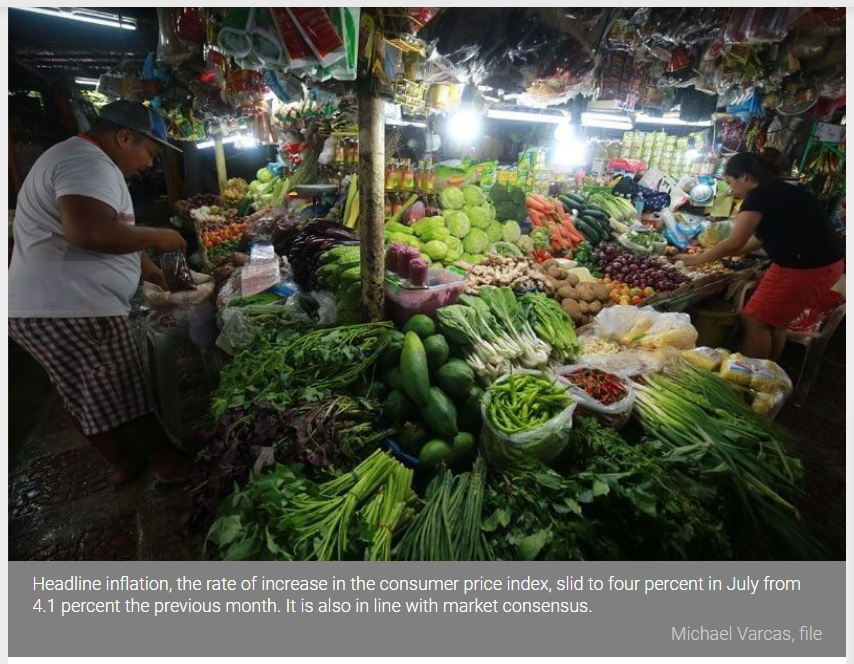Philippines: Inflation slows to 4% in July
Slides back to within government target
MANILA, Philippines — Inflation further eased in July, sliding back to within the government target for the first time this year, as transport prices decelerated, but rising costs of some items in the food basket are fueling concerns this would affect prices in the coming months.
Headline inflation, the rate of increase in the consumer price index, slid to four percent in July from 4.1 percent the previous month. It is also in line with market consensus.
However, it is still much quicker than the 2.7 percent recorded in the same period last year.
Nonetheless, the July inflation marked the first time the headline rate fell within the Bangko Sentral ng Pilipinas’ two to four percent target since December 2020. It is also lower than the BSP’s 4.3 percent forecast for the month.
Still, year-to-date inflation averaged at 4.4 percent, breaching the central bank’s 2021 target.
In a briefing yesterday, National Statistician Dennis Mapa said the main source of slowdown in July inflation was transport, which shared 77.5 percent of the overall downtrend.
Transportation costs, which had a 14.5 percent share to the headline rate, slid to seven percent from 9.6 percent as base effects from pandemic-related rules for public transportation faded.
Fares went down to 11.3 percent while petroleum and fuels decreased to 17.7 percent, with the move to increase the carrying capacity in public transport contributing to the decline in fares even as oil prices remain elevated.
But Mapa expressed concern over the heavily weighted food and non-alcoholic beverages, which posted a faster annual increment of 4.9 percent from 4.7 percent the previous month.
In particular, fish went up to 9.3 percent from 8.7 percent while vegetables surged to five percent from a deceleration of 2.7 percent in June.
“In the food basket, we are looking at fish because it’s been increasing since March. While there are particular species whose prices are going down, the majority are still increasing,” Mapa said.
“As to the vegetables, it was a combination of the bad weather last month and impact of transport prices,” he said.
And while meat inflation eased to 16 percent from 19.2 percent, Mapa said such a rate remains substantial.
“The contributor to the easing of meat inflation was the price of chicken. In terms of pork, the decline was very negligible,” he said.
Also contributing to the inflation were increases in the prices of housing, water, electricity, gas and other fuels, which had a 14.7 percent share of the headline rate. This was driven by rentals, liquefied petroleum gas (LPG) and electricity.
Alex Holmes of Capital Economics said further declines in inflation are likely as the low base from last year’s slump in oil prices slips out of the annual comparison.
Global oil prices are seen going down, with Brent crude set to fall to $70 per barrel by end-2021 from the current $73 per barrel.
“While this will be offset somewhat by a weaker peso, it should still push transport price inflation into negative territory next year,” Holmes said.
“The ramp-up in imports to ease meat shortages also appears to be working and this should continue over the coming months. The upshot is that the headline rate is likely to fall further and should hit the bottom of the BSP’s target range by the end of the year. This should give BSP some space to ease policy further,” he said.
Rizal Commercial Banking Corp. chief economist Michael Ricafort said inflation could have already reached the peak of 4.7 percent in February as food prices eased due to non-monetary measures to boost local supply.
Ricafort noted that inflation could ease further until September but may lead to another uptick by October to about 4.5 percent.
“This is in time for the typhoon season in a typical year that could lead to some storm damage and some temporary pick up in food and agricultural products, before headline inflation could ease significantly to three percent,” he said.
Meanwhile, inflation in the National Capital Region remained at 3.2 percent while that of the areas outside NCR also slid to 4.3 percent.
On the other hand, consumer prices for the country’s poorest households slightly went up as CPI for the bottom 30 percent income households accelerated to 4.4 percent. This brings the year-to-date average to 4.8 percent.
Faster growth was seen in the indexes of food and non-alcoholic beverages, particularly vegetables and fish. Decrements, however, were noted in alcoholic beverages and tobacco, and transport, among others.
It should be noted that the weights for inflation in the bottom 30 percent households are different from that of the average households, thus, the varying rates.
Prices of consumer goods for the poorest households outside the NCR inched up to 4.4 percent. Inflation in NCR also increased to 4.3 percent from 4.1 percent.
Source: https://www.philstar.com/business/2021/08/06/2117869/inflation-slows-4-july


 Thailand
Thailand




